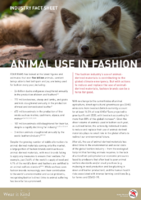
Animal Use in Fashion: Enormous numbers and little oversight of welfare
Over five billion animals are used every year in the fashion industry with many suffering from cruel practices and poor welfare standards
The fashion industry is one of the largest contributors to environmental degradation and animal suffering, which the latest estimates by FOUR PAWS highlighted. Animals are sentient beings which means that they are capable of experiencing a variety of emotions and sensations, including pleasure, pain, joy, and fear. In fact, many animals can exhibit complex emotions like grief and empathy. Animals' feelings hold significance and deserve consideration.
Every animal counts. Nevertheless, when dealing with such massive numbers of animals and minimal consideration for their well-being, they are often treated as mere objects. The unbelievable number of five billion animals affected by the lack of animal welfare standards in fashion includes:
- 3.4 billion ducks and geese used for down and feathers1, 2
- 777 million cows, sheep, lambs, and goats slaughtered for meat and leather3
- 672 million animals (merino sheep, cashmere goats, alpaca, angora goats and rabbits) for the production of fine wools4
- 107 million animals slaughtered for fur5
- 3 million wild animals slaughtered for exotic leather6
Animals are sentient beings and experience both physical and psychological pain
Our brains generally struggle with comprehending large numbers, which can make it challenging to fully grasp the extent of the suffering that billions of animals endure in the fashion industry. To put this into context the number of animals used for fashion on a yearly basis is more than three times the entire population of India (the most populous country on the planet) or more than half of the current world population.7 Surprised?
Despite the already enormous impact of the textiles industry on animal lives, only a small fraction of animal-derived materials are certified to meet animal welfare standards. For example:
- less than 3% of the world's supply of wool
- around 4% of the world's down and feathers
- and less than 1% of alpaca wool is certified to an animal welfare standard.
This lack of certification indicates that the welfare of these animals is often overlooked, and many suffer from poor welfare standards and cruel practices such as mulesing, live plucking or intensive keeping.
Animal-use data

The impacts of animal use in fashion
The sheer volume of animals used in fashion each year is contributing to the worldwide pressures on our planetary boundaries. Animal agriculture accounts for up to 16.5% of global GHG emissions8, making it a significant contributor to the climate crisis. Additionally, the environmental impacts of livestock farming, including land use and degradation, water scarcity, waste flows of pollutants and the nutrient elements nitrogen and phosphorus all contribute to unprecedented threats to climate and biodiversity.

The fashion industry's use of animal-derived materials also has human health risks. In 2020, we saw a direct link between the spread of zoonotic diseases and the global fashion industry when COVID-19 spread to minks on fur farms in the EU. Mink farms in 10 countries have since been hit by outbreaks, including the U.S., Canada, France, Greece, Italy, Latvia, Lithuania, Poland, Spain and Sweden.9 The intensity of commercial farming systems to keep up with the demand of animal-derived products in fashion therefore increases the risk of zoonotic diseases like COVID-19. The use of animal-derived materials is not sustainable in the long term. It is therefore imperative that the fashion industry takes steps to reduce and replace the use of animal-derived materials with sustainable alternatives derived from circular and restorative production systems.
What can be done
To create a fashion industry that is kind to animals and the planet FOUR PAWS recommends the following key principles:
- Look for pre-loved or seek out sustainable animal-free fashion options.
- Write to your favourite brands and ask them to stock sustainable and animal-free apparel.
- If you are going to buy clothing made from animals hair, skin or feathers, at minimum ensure it’s certified to rule out mulesing and live plucking. And remember for leather, there are virtually no products even certified to an animal welfare standard.
In a nutshell, the approach for companies as well as consumers should be to Refine, Reduce, and Replace.
Consumers along with brands will play a crucial role in driving this change by supporting sustainable and ethical fashion solutions.
Together we can create a more sustainable and compassionate fashion industry that benefits animals, people, and the planet.
Fashion not only has to look and feel great, it has to be great.
Source
2 Down and feather market – Growth, Trends, COVID-19 Impact, and Forecasts (2022-2027). Mordor Intelligence; 2023 [accessed 17 January 2023].
3 World statistical compendium for rawhides and skins, leather and leather footwear 1999-2015, The United Nations Food and Agriculture Organization; 2016 [accessed 17 January, 2023].
4 Animal Use in Fashion Fact Sheet, FOUR PAWS; 2023 [accessed 19 April, 2023]. https://media.4-paws.org/8/0/8/7/8087eb5d763358f8ef231b87c200172c17ffd4c9/2023-03_FAN_animals_in_fashion_factsheet_EN.pdf
5 Animal Use in Fashion Fact Sheet, FOUR PAWS; 2023 [accessed 19 April, 2023]. https://media.4-paws.org/8/0/8/7/8087eb5d763358f8ef231b87c200172c17ffd4c9/2023-03_FAN_animals_in_fashion_factsheet_EN.pdf
6 Animal Use in Fashion Fact Sheet, FOUR PAWS; 2023 [accessed 19 April, 2023]. https://media.4-paws.org/8/0/8/7/8087eb5d763358f8ef231b87c200172c17ffd4c9/2023-03_FAN_animals_in_fashion_factsheet_EN.pdf
7 Worldometer – real time world statistics. [accessed 18 April, 2023]. https://www.worldometers.info/
8 Tackling climate change through livestock: a global assessment of emissions and mitigation opportunities; 2013 [accessed 6 February, 2023].
9 Fashions to die for: The fur trade’s role in spreading zoonotic disease. Mongabay; 2021 [accesed 6 February, 2023]. https://news.mongabay.com/2021/09/fashions-to-die-for-the-fur-trades-role-in-spreading-zoonotic-disease/




